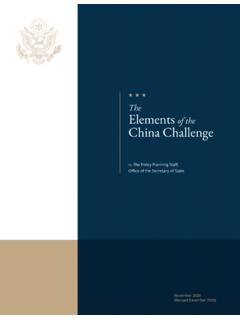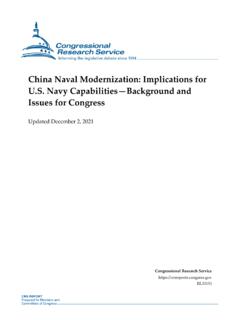Transcription of Historical Timeline of Important US Political Parties FINAL
1 Historical Timeline of Important Political Parties in the United States 1789 - Federalist Party The Federalist Party, referred to as the Pro-Administration party until the 3rd United States Congress, was the first American Political party. It existed from 1789 to 1820. It appealed to business and to conservatives who favored banks, national over state government, manufacturing, and (in world affairs) preferred Britain and opposed the French Revolution. The Federalists called for a strong national government that promoted economic growth and fostered friendly relationships with Great Britain as well as opposition to revolutionary France.
2 The party controlled the federal government until 1801, when it was overwhelmed by the Democratic-Republican opposition led by Thomas Jefferson. 1792 - Democratic-Republican Party The Democratic-Republican Party was an American Political party formed by Thomas Jefferson and James Madison around 1792 to oppose the centralizing policies of the new Federalist Party run by Alexander Hamilton, who was secretary of the treasury and chief architect of George Washington's administration. From 1801 to 1825, the new party controlled the presidency and Congress as well as most states during the First Party System.
3 It began in 1791 as one faction in Congress and included many politicians who had been opposed to the new constitution. They called themselves "Republicans" after their ideology, republicanism. They distrusted the Federalist commitment to republicanism. 1828 Democratic Party The Democratic Party is one of the two major contemporary Political Parties in the United States, along with the Republican Party. Tracing its heritage back to Thomas Jefferson and James Madison's Democratic-Republican Party, the modern-day Democratic Party was founded around 1828 by supporters of Andrew Jackson, making it the world's oldest active Political party.
4 The Democrats' dominant worldview was once social conservatism and economic liberalism while populism was its leading characteristic in the rural South. In 1912, Theodore Roosevelt ran as a third-party candidate in the Progressive "Bull Moose" Party, leading to a switch of Political platforms between the Democratic and Republican Party and Woodrow Wilson being elected as the first fiscally progressive Democrat. Since Franklin D. Roosevelt and his New Deal coalition in the 1930s, the Democratic Party has also promoted a social liberal platform, supporting social justice.
5 1830 Whig Party The Whig Party was a Political party active in the middle of the 19th century in the United States. Four Presidents belonged to the party while in office. It emerged in the 1830s as the leading opponent of the Jacksonians. It had links to the upscale traditions of the Federalist Party. Along with the rival Democratic Party, it was central to the Second Party System from the early 1840s to the mid-1860s. Formed in opposition to the policies of President Andrew Jackson, the Whigs supported the supremacy of the United States Congress over the presidency and favored a program of modernization , banking and economic protectionism to stimulate manufacturing.
6 1848 Free Soil Party The Free Soil Party was a short-lived Political party in the United States active in the 1848 and 1852 presidential elections as well as in some state elections. A single-issue party, its main purpose was to oppose the expansion of slavery into the Western territories, arguing that free men on free soil constituted a morally and economically superior system to slavery. It also sometimes worked to remove existing laws that discriminated against freed African Americans in states such as Ohio. The party originated in New York after the state Democratic convention refused to endorse the Wilmot Proviso, a proposed law that would have banned slavery in any territory acquired from Mexico in the Mexican American War.
7 1854 Republican Party The Republican Party, also referred to as the GOP (abbreviation for Grand Old Party), is one of the two major Political Parties in the United States, the other being its historic rival, the Democratic Party. The party is named after republicanism, a major ideology of the American Revolution. The Republicans largely dominated politics nationally and in the majority of northern states between 1860 and 1932. Founded in the Northern states in 1854 by anti-slavery activists, modernizers, ex-Whigs and ex-Free Soilers, the Republican Party quickly became the principal opposition to the dominant Democratic Party and the briefly popular Know Nothing Party.
8 The main cause was opposition to the Kansas Nebraska Act, which repealed the Missouri Compromise by which slavery was kept out of Kansas. The Northern Republicans saw the expansion of slavery as a great evil. 1869 Prohibition Party The Prohibition Party, founded in 1869, succeeded in getting communities and many counties in the states to outlaw the production and sale of intoxicating beverages. Its proudest moment came in 1919, with the passage of the 18th Amendment to the United States Constitution, which outlawed the production, sale, transportation, import and export of alcohol.
9 The era during which alcohol was illegal in the United States is known as "Prohibition". While it declined dramatically after the repeal of Prohibition in 1933, it is still functioning today and is the oldest existing third party in the US. The party's candidate received 518 votes in the 2012 presidential election and 5,617 votes in the 2016 presidential election. 1901 Socialist Party The Socialist Party of America (SPA) was a multi -tendency democratic socialist and social democratic Political party in the United States formed in 1901 by a merger between the three-year-old Social Democratic Party of America and disaffected elements of the Socialist Labor Party of America which had split from the main organization in 1899.
10 In the first decades of the 20th century , it drew significant support from many different groups, including trade unionists, progressive social reformers, populist farmers and immigrants. However, it refused to form coalitions with other Parties , or even to allow its members to vote for other Parties . Its candidate, Eugene V. Debs, twice won over 900,000 votes in presidential elections (1912 and 1920). 1912 - Progressive Party The Progressive Party was a third party in the United States formed in 1912 by former President Theodore Roosevelt after he lost the presidential nomination of the Republican Party to his former prot g , incumbent President William Howard Taft.





